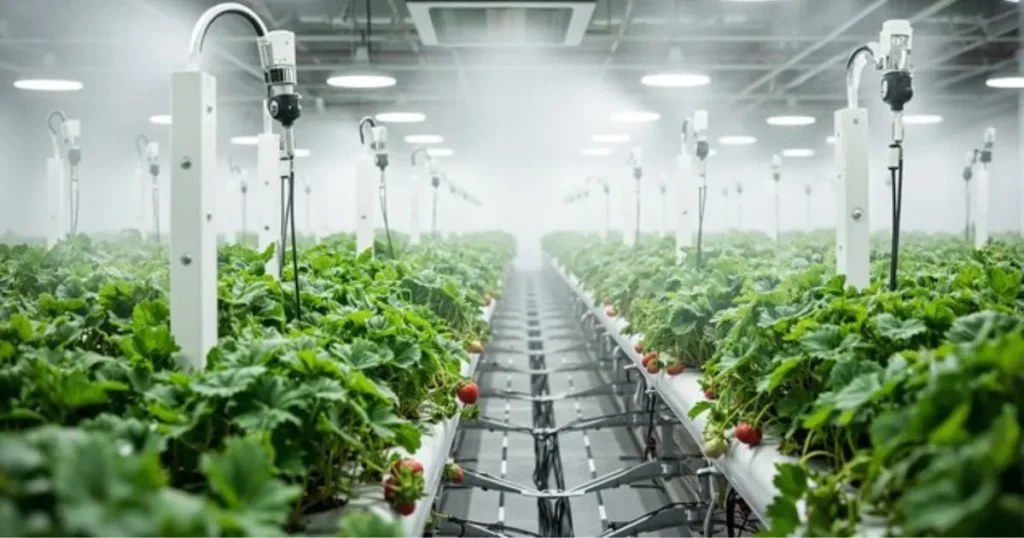Urban Farming Revolution: How Hydroponics & Aeroponics Thrive
Table of Contents
ToggleIntroduction
Urban farming is transforming the way we grow food in cities, and two cutting-edge techniques—hydroponics and aeroponics—are at the forefront of this revolution. These soil-less farming methods maximize space, conserve water, and produce fresh, pesticide-free food year-round. As urban populations grow, traditional agriculture struggles to meet demand. Hydroponics and aeroponics provide a sustainable and efficient solution, making them the future of urban farming.
What is Hydroponics?
Hydroponics is a method of growing plants without soil, using a nutrient-rich water solution. This technique provides plants with direct access to essential nutrients, resulting in faster growth and higher yields. Some popular hydroponic systems include:
- Deep Water Culture (DWC): Plants are suspended in nutrient-rich water, ensuring a constant supply of oxygen and nutrients.
- Nutrient Film Technique (NFT): A thin layer of nutrient solution continuously flows over plant roots, optimizing absorption.
- Ebb and Flow System: Water floods the growing area at intervals, keeping roots hydrated while allowing oxygenation.
What is Aeroponics?
Aeroponics is an advanced form of hydroponics where plants grow in an air or mist environment, without soil or a solid medium. Instead of being submerged in water, the roots are suspended in air and regularly misted with a nutrient solution. This method:
- Uses 90% less water than traditional farming.
- Delivers nutrients more efficiently, resulting in 30-50% faster plant growth.
- Reduces the risk of soil-borne diseases and pests, minimizing pesticide use.
Advantages of Hydroponics and Aeroponics for Urban Farming
Maximized Space Utilization
.
With vertical farming setups, hydroponics and aeroponics make the most of limited urban space. Skyscraper farms and rooftop gardens can grow fresh produce in the heart of cities, making urban farming more practical and scalable.
Water Conservation
.
Traditional agriculture is highly water-intensive, but hydroponic and aeroponic systems use up to 95% less water by recycling nutrient solutions. This makes them ideal for regions with water scarcity.
Higher Yield and Faster Growth
.
Since plants receive direct access to nutrients, they grow faster and produce higher yields than soil-based farming. Hydroponics and aeroponics can yield 3-10 times more per square foot compared to traditional farming.
Year-Round Production
.
Urban farming with hydroponics and aeroponics enables controlled-environment agriculture (CEA), where temperature, light, and humidity are optimized. This allows year-round food production, regardless of external weather conditions.
Chemical-Free and Healthier Food
.
Since these systems are soil-free, they eliminate the need for chemical pesticides and herbicides, resulting in clean, organic, and pesticide-free produce.
Reduced Carbon Footprint
.
Locally grown food eliminates the need for long-distance transportation, reducing carbon emissions. Hydroponics and aeroponics further contribute to sustainability by using renewable energy sources such as solar power.
Challenges and Solutions in Hydroponic and Aeroponic Urban Farming
-
Bacteria: The Remarkable Role of Microbes for Growing Plants in Hydroponics
-
Hydroponics: The Rookie Mistakes of Growing Plants
-
Chlorine: The Incredible Key to Thriving Hydroponic Plants
-
Molybdenum: Astonishing Importance for Hydroponic Plant Growth
-
Boron: The Astonishing Importance for Plants Growing in Hydroponics
-
Copper: A Powerful Element for Hydroponic Plant Growth
-
Zinc: The Powerful Secret to Hydroponic Plant Growth
-
Manganese: Essential role for Hydroponic Plant Growth
-
Iron: The Crucial Role of Iron in Hydroponic Plant Growth
-
Sulfur: The Vital Key to Thriving Hydroponic Plant Growth
-
Magnesium: The Crucial Role for Thriving Hydroponic Plants
-
Calcium: The Critical Importance for Thriving Hydroponic Plants
Initial Investment Costs
Setting up hydroponic and aeroponic systems requires an initial investment in infrastructure and equipment. However, the long-term benefits—higher yields, reduced resource consumption, and lower operational costs—make it a worthwhile investment.
Power Dependency
These systems rely on electricity for water circulation, misting, and climate control, making them vulnerable to power outages. Integrating solar energy, battery storage, and backup power solutions can make urban farming operations more resilient and sustainable.
Technical Knowledge and Maintenance
Urban farming using hydroponics and aeroponics requires technical knowledge of nutrient management and system maintenance. To overcome this, many startups offer training programs and automated systems that simplify the process.
To know more about Hydroponics
Future of Urban Farming with Hydroponics and Aeroponics
The future of urban farming is bright, with hydroponics and aeroponics playing a crucial role in ensuring food security in cities. Innovations such as AI-driven automated farming, IoT-enabled monitoring systems, and biodegradable growing mediums are making these systems more efficient and accessible.
Governments and private investors are increasingly supporting urban farming initiatives, recognizing their potential to combat food shortages and promote sustainability. With continuous advancements in technology, we can expect a rapid expansion of hydroponic and aeroponic farms worldwide.
Conclusion
Hydroponics and aeroponics are revolutionizing urban farming by offering sustainable, efficient, and space-saving solutions for food production. With their ability to conserve water, maximize yields, and reduce environmental impact, these cutting-edge farming methods are the future of food security in cities. As the world moves towards greener and smarter agricultural practices, embracing hydroponics and aeroponics will be key to creating a more resilient and sustainable urban food system.

